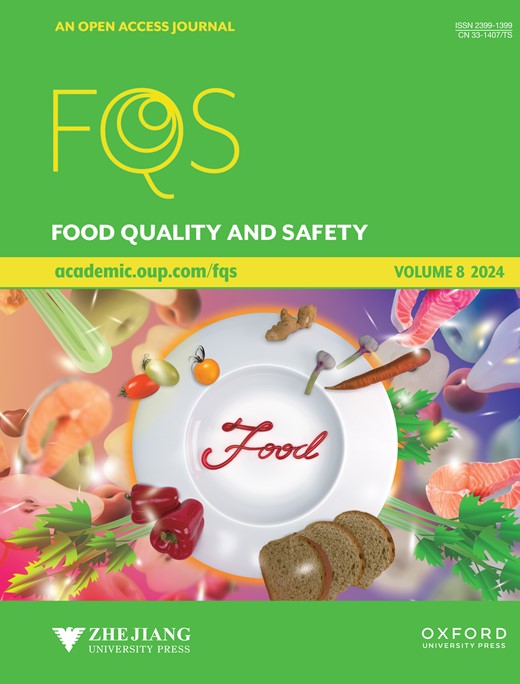中国露天栽培与温室栽培莴苣蜡样芽孢杆菌风险评价比较研究
IF 4.4
3区 农林科学
Q2 FOOD SCIENCE & TECHNOLOGY
引用次数: 0
摘要
摘要从蔬菜中分离的蜡样芽孢杆菌可引起腹泻综合征食物中毒。生菜是最常食用的即食蔬菜,具有暴露于蜡样芽孢杆菌的重大风险。因此,在培养过程中对蜡样芽孢杆菌的监测和评价对于预防由这种食物病原体组合引起的食源性疾病至关重要。然而,不同的栽培方法对生菜中蜡样芽孢杆菌污染的影响目前尚不清楚。此外,实验模型的有效性指标在现场条件下无法得到有效验证。在此,我们使用定量微生物风险评估模型评估了在中国两种不同栽培系统(露天和温室)下种植的生菜暴露于蜡样芽孢杆菌的风险。采用Tukey的均值比较方法和核密度估计频率分布统计量对环境样本和生菜进行模型验证。露天生菜中蜡样芽孢杆菌的平均浓度显著高于温室生菜(p <0.05)。环境样品或生菜的测量值、公式计算值和风险评估值之间没有显著差异(p >0.05),验证风险模型的准确性。在控制生菜中蜡样芽孢杆菌浓度的农业实践中,应考虑土壤日晒、全粪肥处理、地膜使用和灌溉水质。总体而言,我们发现露天生菜中蜡样芽孢杆菌的含量更高,我们提供了一个风险评估框架,可以指导中国农民和决策者控制从农场到餐桌的生菜链中的蜡样芽孢杆菌污染。本文章由计算机程序翻译,如有差异,请以英文原文为准。
Risk assessment of Bacillus cereus in lettuce grown in open-field and greenhouse farming systems in China: A comparative study
Abstract Bacillus cereus isolates from vegetables can cause diarrheal syndrome food poisoning. Lettuce, the most highly consumed ready-to-eat vegetable, poses a significant risk of B. cereus exposure. Hence, B. cereus monitoring and evaluation during cultivation are essential for preventing foodborne illnesses caused by this food–pathogen combination. However, the impact of different cultivation practices on B. cereus contamination in lettuce currently remains unclear. Furthermore, validity indicator of the experimental models cannot be effectively validated under field conditions. Herein, we assessed the risk of B. cereus exposure using lettuce grown under two different cultivation farming systems in China(open-field versus greenhouse) using a quantitative microbial risk assessment model. Tukey’s mean comparison method and kernel density estimation frequency distribution statistics were used for model validation using environmental samples and lettuce. The mean concentration of B. cereus in open-field-grown lettuce was significantly higher than in greenhouse-grown lettuce (p < 0.05). No significant differences were observed between measured, formula-calculated, and risk assessment values in environmental samples or lettuce (p > 0.05), verifying the accuracy of the risk model. Soil solarization, complete manure treatment, usage of mulch films, and irrigation water quality should be considered in agricultural practices to control B. cereus concentrations in lettuce. Overall, we found that B. cereus was more abundant in open-field-grown lettuce, and we provide a risk evaluation framework that can guide farmers and policy-makers to control B. cereus contamination in farm-to-fork lettuce chains in China.
求助全文
通过发布文献求助,成功后即可免费获取论文全文。
去求助
来源期刊

Food Quality and Safety
FOOD SCIENCE & TECHNOLOGY-
CiteScore
7.20
自引率
1.80%
发文量
31
审稿时长
5 weeks
期刊介绍:
Food quality and safety are the main targets of investigation in food production. Therefore, reliable paths to detect, identify, quantify, characterize and monitor quality and safety issues occurring in food are of great interest.
Food Quality and Safety is an open access, international, peer-reviewed journal providing a platform to highlight emerging and innovative science and technology in the agro-food field, publishing up-to-date research in the areas of food quality and safety, food nutrition and human health. It promotes food and health equity which will consequently promote public health and combat diseases.
The journal is an effective channel of communication between food scientists, nutritionists, public health professionals, food producers, food marketers, policy makers, governmental and non-governmental agencies, and others concerned with the food safety, nutrition and public health dimensions.
The journal accepts original research articles, review papers, technical reports, case studies, conference reports, and book reviews articles.
 求助内容:
求助内容: 应助结果提醒方式:
应助结果提醒方式:


